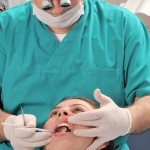
Visual and visual-tactile approaches are the mainstay of caries detection in general dental practice. While this approach is usually effective for detecting caries into dentine detection at earlier stages in the caries process is possible and affords the opportunity of remineralisation of the tooth surface or other preventive treatment. A number of adjunctive detection and diagnostic technologies can be used to support visual methods including, fluorescence, radiographic imaging and cone beam computed tomography (CBCT), optical coherence tomography and transillumination, and electrical conductance or impedance. This year Cochrane Oral Health have published separate caries diagnostic test accuracy reviews of these technologies as well as visual and visual-tactile approaches (Dental Elf- 6th Jan 2021; 1st Feb 2021; 19th Mar 2021; 22nd Mar 2021; 16th Jun 2021).
The aim of this paper was to conduct a formal comparative analysis of the diagnostic accuracy of different technologies to detect and inform the diagnosis of early caries using published Cochrane systematic reviews.
Methods
Using data from the 5 Cochrane caries diagnostic test reviews two analyses were conducted based on study design: a fully within-study, within-person analysis that directly evaluated ≥3 of the same multiple index tests and a network meta-analysis based on direct and indirect comparisons where at least 2 index tests had been directly compared. QUADAS- 2 assessments from the original Cochrane review were used.
Results
- 158 studies were included in the 5 Cochrane reviews, 19 studies provided data for the fully within-person analysis and 64 studies for the network meta-analysis.
- 19 datasets (2849 tooth site/surfaces) were included in this first analysis with accuracy estimates for one model shown below.
| Sensitivity
[95% Prediction Interval] |
Specificity
[95% Prediction Interval] |
|
| Fluorescence | 0.71 [0.10, to 0.98] | 0.88 [0.18, to 1.00] |
| Imaging (x-rays) | 0.48 [0.04, to 0.98] | 0.89 [0.23, to 1.00] |
| Visual | 0.82 [0.17, to 0.98] | 0.85 [0.13, to 1.00] |
- Visual classification and fluorescence outperformed radiographic imaging in terms of sensitivity with similar specificity estimates.
- The 64 studies (24,567 tooth sites, 70% prevalence of enamel caries) included in the second analysis included data for all 5 technologies with variations between the technologies being shown in the table below.
| Sensitivity
[95% Prediction Interval] |
Specificity
[95% Prediction Interval] |
|
| Visual | 0.83 [0.28, to 0.98] | 0.81 [0.19, to 0.99] |
| Fluorescence | 0.76 [0.20, to 0.97] | 0.83 [0.23, to 0.99] |
| Imaging | 0.50 [0.07, to 0.92] | 0.89 [0.31, to 0.99] |
| Electrical conduction | 0.83 [0.24, to 0.99] | 0.72 [0.12, to 0.98] |
| Transillumination & optical coherence tomography (OCT) | 0.76 [0.20, to 0.98] | 0.82 [0.21, to 0.99] |
- Using an estimated caries prevalence of 28% (UK adult data) the impact on false positive and false negative diagnosis of the various technologies is shown in the table below.
| True positives (95%CI) | False negatives
(95%CI) |
True negatives
(95%CI) |
False positives
(95%CI) |
|
| Visual | 232 (216, 244) | 48 (36, 64) | 583 (526, 626) | 137 (94, 194) |
| Fluorescence | 213 (190, 2330) | 67 (50, 90) | 598 (540, 641) | 122 (79, 180) |
| Imaging | 140 (112, 165) | 140 (115, 168) | 641 (598, 670) | 79 (50, 122) |
| Electrical conduction | 232 (185, 258) | 48 (22, 95) | 518 (317, 641) | 202 (79, 403) |
| Transillumination & OCT | 213 (176, 241) | 67 (39, 104)
|
590 (490, 655) | 130 (65, 230) |
- The overall certainty of evidence was considered to be low.
Conclusions
The authors concluded: –
Summary estimates of diagnostic accuracy for most technologies indicate that the degree of certitude with which a decision is made regarding the presence or absence of disease may be enhanced with the use of such devices. However, given the broad prediction intervals, it is challenging to predict their accuracy in any future “real world” context.
Comments
We have previously considered each of these individual Cochrane diagnostic test accuracy reviews separately (Dental Elf- 6th Jan 2021; 1st Feb 2021; 19th Mar 2021; 22nd Mar 2021; 16th Jun 2021). So this paper which provides a collaborative assessment of the 5 Cochrane reviews is welcome. However as the authors point out there are problems with the body of available evidence because of availability of only imperfect reference standards and the many of the available studies were conducted on extracted teeth. In addition, there is the impact of spectrum bias as a high proportion of the teeth had caries. Perhaps then reassuringly visual and visual-tactile detection of caries performs well but could be improved by the use of classification systems such as ICDAS or Ekstrand-Ricketts-Kidd
Links
Primary Paper
Walsh T, Macey R, Ricketts D, Carrasco Labra A, Worthington H, Sutton AJ, Freeman S, Glenny AM, Riley P, Clarkson J, Cerullo E. Enamel Caries Detection and Diagnosis: An Analysis of Systematic Reviews. J Dent Res. 2021 Oct 12:220345211042795. doi: 10.1177/00220345211042795. Epub ahead of print. PMID: 34636266.
Other references
Dental Elf – Jun 2021
Dental Elf – 22nd Mar 2021
Dental Elf – 19th Mar 2021
Dental imaging methods for early caries detection and diagnosis
Dental Elf – 1st Feb 2021
Dental Elf- 6th Jan 2021
